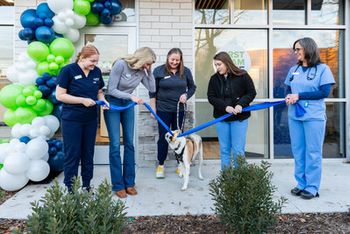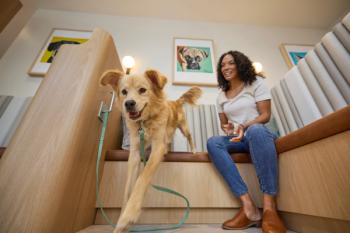
Stand-out design without the freestanding facility
I always knew I wanted to own a practice, but I never guessed that the perfect location would be a strip mall," says Dr. Jean M. Oberg, owner of My Animal Hospital of North Dover in Toms River, N.J. "In 1984, I started cutting hospital design articles out of Veterinary Economics, and when it came time to build, I had hundreds of designs."
By Sarah A. Moser, Associate Editor
"I always knew I wanted to own a practice, but I never guessed that the perfect location would be a strip mall," says Dr. Jean M. Oberg, owner of My Animal Hospital of North Dover in Toms River, N.J. "In 1984, I started cutting hospital design articles out of Veterinary Economics, and when it came time to build, I had hundreds of designs."
Dr. Oberg says that at first she thought she wouldn't get what she wanted in a strip-mall practice. But now she couldn't be happier with the facility, which won a Merit Award in the 2002 Veterinary Economics Hospital Design Competition.
"I searched for four years for a freestanding building, but never found what I wanted or what I could afford," says Dr. Oberg, who practiced as an associate and in her own house-call practice for 15 years before building. "The strip-mall option made my dream a reality."
Dreamed turned reality
Once Dr. Oberg found the location-a brand new strip mall on a highly visible road-her next step was to decide whether she wanted to rent one bay or two. "I called doctors who practice in strip malls and asked for advice," she says. "The resounding answer: Get as much space as possible." She rented two bays in the retail center, then started creating a floor plan.
"I had 16 year's worth of floor plans and design ideas at hand, so I spread them over the table and used them to make a list of every element I wanted in my practice," she says. "I put all of my ideas on paper, and I hired an architect to finalize my plan."
Her must-haves included a kids' area modeled after a veterinary hospital; radiograph viewboxes in both exam rooms and in the surgical suite; a central vacuum system; and a homey atmosphere. And she says she sketched many versions of the plan before she fit everything in. One concession: She adamantly wanted a break room, and in the end that meant eliminating a radiology room.
Hiring an architect to formalize her plan proved easy. While asking fellow practitioners for advice on her practice size, she also learned about their architects. Local architect Richard Luthringer came highly recommended, and he cleaned up her rough plan and filled in the technical details.
Dr. Oberg didn't know until too late that she could have hired a subcontractor to handle the details. Instead, she hired the plumber, flooring contractors, and others herself and monitored their work. "Several of the contractors were clients of mine, so it worked out fine," she says. "I trusted them a great deal, and my house-call practice offered me the flexibility to schedule around meetings with workers."
Setting the plan in motion
Dr. Oberg hired support staff members before opening the practice, so she had time to train them in advance. For example, three months before opening, she and her computer network installer, Larry Carroll, set up the computer system in her house to make sure it worked. Then she and her staff members spent three days learning the ropes, inputting codes, and gearing up for the grand opening.
At the facility Dr. Oberg and her father added such finishing touches as a holding cage below the reception desk to hold pets during check out; a snack and coffee station in the reception area; a courtesy phone; and flat-screen computer monitors to conserve reception desk space. The large retail area includes pet food and supplies as well as Barbie Veterinarian dolls and other goodies for kids.
Lessons learned, changes made
Six months after completion, Dr. Oberg cut boarding and grooming completely from her practice and retooled the space to be a combination third exam room and comfort room. Why? "I realized that the money we could bring in from a third exam room was almost double what boarding and grooming made," she says. "But that's not even the main reason I made the change. Boarding and grooming meant extra dogs barking in the practice. And boarding meant hiring extra staff members on the weekends. These ancillary services introduced more problems than they were worth. We're much happier now."
Dr. Oberg sold her grooming tables to a doctor who was setting up shop nearby and sold her cages to a breeder. With the proceeds she bought leather and cherry wood furniture for the comfort room.
Dr. Oberg also added a fenced-in dog walk area outside the practice. She included a cement bench and fire hydrant for added effect and provides biodegradable mitts for picking up dog droppings.
Since the hospital opened a year ago, two full-time associates have joined the practice, as well as two part-time doctors, one of which conducts house calls. And the hospital became AAHA-certified. "We hit the ground running, and we just keep growing," Dr. Oberg says.
Strip-mall advice
Building in a strip mall has its own challenges and benefits, Dr. Oberg says. While it wasn't her first choice for how to build her hospital, she says it has worked out so well that she'd do it again in a heartbeat. So what's the key to making a strip mall facility work for you?
"You've heard that location is key, and that's especially true in a strip mall," she says. "Look for a place with great visibility and traffic. And try for a corner bay, if possible, to have more space for walking dogs and generally more parking spaces on the side of the building."
The next step: Search for a nice landlord. "I couldn't ask for a better, more cooperative landlord, and that has made all the difference," says Dr. Oberg. "If a potential landlord turns up his nose at an animal hospital when you broach the idea, he'll be hard to work with once you've moved in. My landlord was excited to have the practice there, and he's still very receptive to us." The same goes for hiring an architect. "Find one you can talk to, who's easy to work with," she says. "The building process is stressful enough. You don't need to add difficult people to the mix."
And finally, Dr. Oberg says you should follow your gut. "If it doesn't feel right, whether you're hiring an architect, choosing a location, or picking a flooring contractor, don't do it," she says. "I failed to follow my gut with one contractor, and I paid for that mistake."
Newsletter
From exam room tips to practice management insights, get trusted veterinary news delivered straight to your inbox—subscribe to dvm360.





